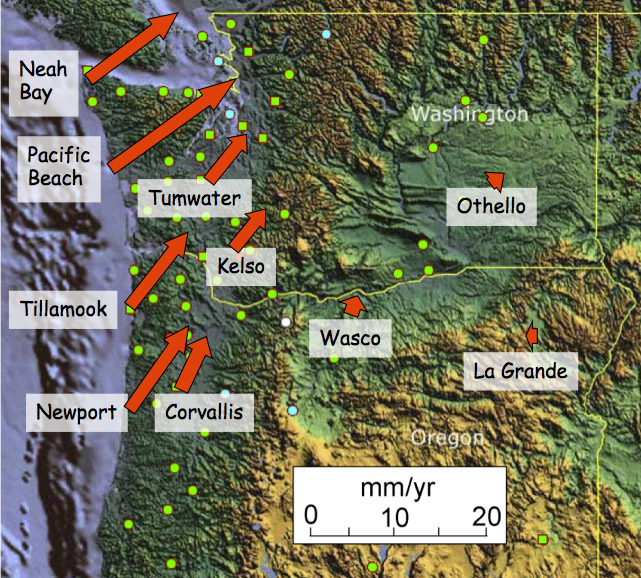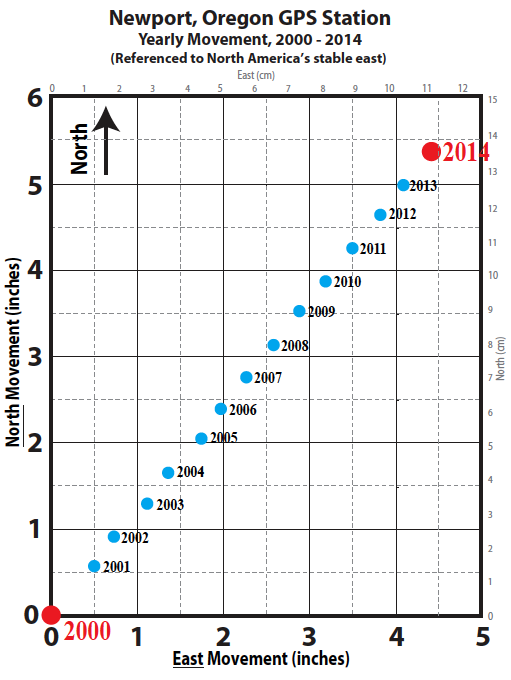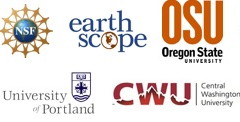Presentations
|
| PowerPoint presentation introducing fundamental concepts of EarthScope Science, Geodesy, and Seismology with a particular emphasis on research related to Cascadia. May be used either as learning aids for educators or edited for their own presentations. Associated animations are included as separate files. |
|
|
|
|
|
|
|
Recent data from the Pacific Northwest and other subduction zones show that there are 3 distinct areas of movement above a subduction zone: 1) constant inland movement above the locked plate edge, 2) see-saw pattern of back-&-forth movement above a zone that alternately locks then slips in a process called episodic tremor and slip, and 3) no movement far inland above the deeper part of the diving oceanic plate.
|
|
This animation shows a close-up of the movement recorded at a GPS station over an ETS region of a subduction boundary. Here we see the station fixed to the ground which is moving northeast on a ~14-month cycle before sliding back accompanied by a gentle seismic shaking shown in the seismogram. Researcher hypothesize that subduction zones are at higher risk of earthquake rupture during periods of ETS.
|
|
This animation compares the subduction zone east of Japan with a mirror-image subduction zone across the Pacific—the Cascadia subduction zone off the coast of the Pacific Northwest. Using GPS, we can watch the surface of the Earth deform in response to the drag of one tectonic plate going under another and clearly observe the deformation occurring in Cascadia that will inevitably lead to more megathrust earthquake and tsunami.
|
|
What makes for an effective earthquake early warning system? With seismic data alone, we cannot determine the magnitude and rupture area of megathrust earthquakes as quickly and effectively as we can with the addition of GPS data. In this animation, we see why Japan's earthquake early warning system underestimated the magnitude of the March 11, 2011 Japan earthquake, leading to underestimates of the earthquake's effects, such as tsunami size.
|
Activities
|
USArray Seismic Wave Visualizations Educator Guide 
These animations show how the ground responds when seismic waves from worldwide earthquakes sweep across more than 400 sensitive seismograph stations of USArray, the seismologic component of EarthScope. The associated documentation support an educator in including this content in their class.
|
Educator Guide
Related Presentation
USArray Visualizations: China 2008, Nevada 2008, Haiti 2010
|
Introduction to GPS (GPS “gumdrop” activity)
This activity allows learners to analyze high-precision GPS observations of deformation of the North American Plate in Cascadia. Learners analyze the rates of motion of three GPS receiving stations at different distances from the Cascadia subduction zone boundary and see how the slowly accumulating elastic energy will be released in the next Cascadia megathrust earthquake!
|
Original Activity Instructions
Revised 2016 Student Worksheet
Revised 2016 Instructor Notes
"How to access data from your nearest GPS station"
|
GPS Part 2 - Locked and Loading
This activity is an enhancement of the GPS Gumdrop activity. It is intended for educators who wish to provide their learners with a more complete spatial picture of deformation of the Pacific Northwest continental margin.
|
Activity Instructions |
Episodic Tremor and Slip (ETS)
Through this activity, learners can learn about an exciting discovery made possible by invention of high-precision GPS receivers and deployment of these receivers across the Pacific Northwest. This activity can be used to illustrate how invention of new technologies can lead to new scientific discoveries that would have been impossible without the new instruments; a good lesson in how science works.
|
Activity Instructions |
GPS Cards
These simple cards showing annual GPS station movements along Cascadia over the last decade or more offer a excellent locally-based confirmation that the ground below the coastal Pacific Northwest is moving and more megathrust earthquakes will inevitably occur.
|
Washington transect
Aberdeen, WA (coastal)
Elma, WA (near field)
Lind, WA (inland)
Northern Oregon transect
Newport, OR (coastal)
Corvallis, OR (near field)
Redmond, OR (inland)
Southern Oregon transect
Bandon, OR (coastal)
Winston, OR (near field)
Silver Lake, OR (inland)
Northern California
Arcata, CA (coastal)
Activity instructions for a related exercise combining nine stations' data
|









